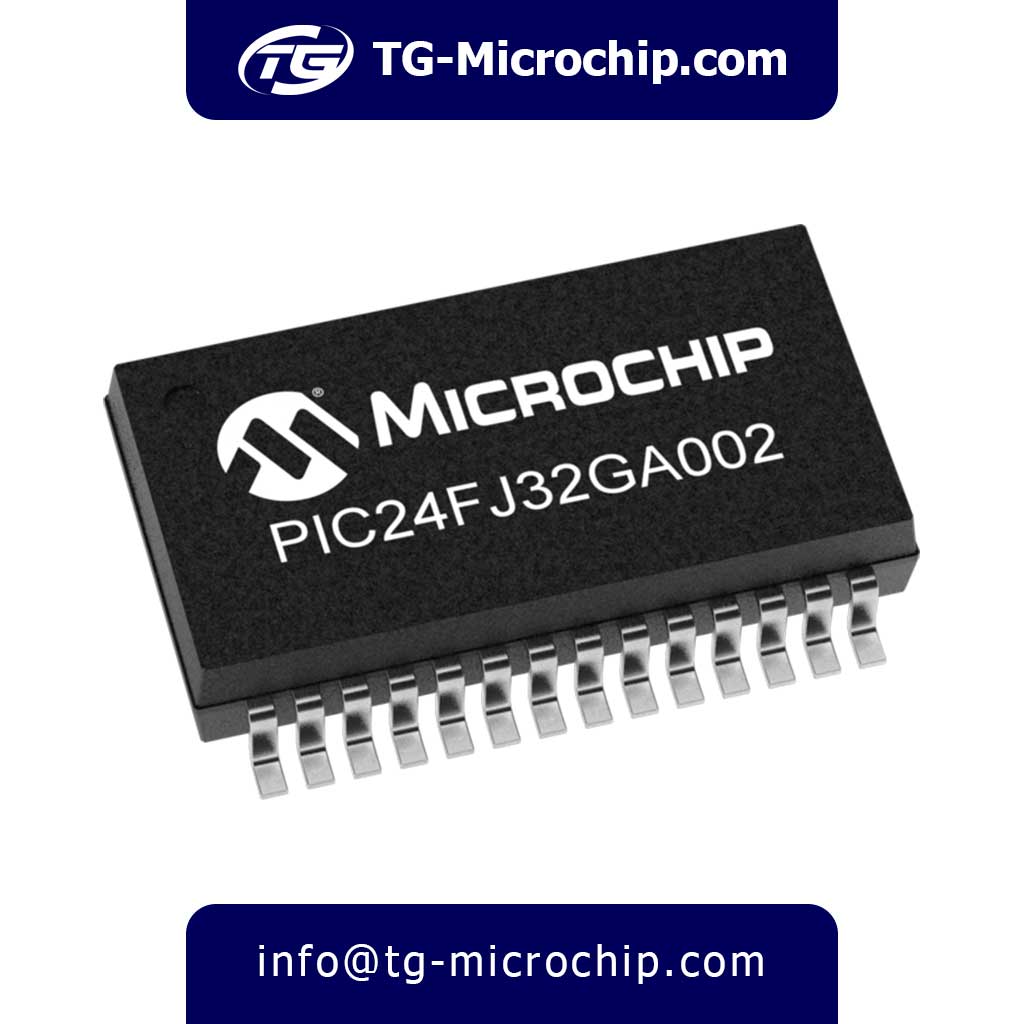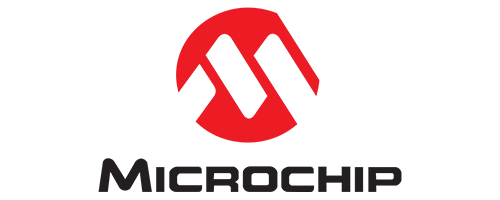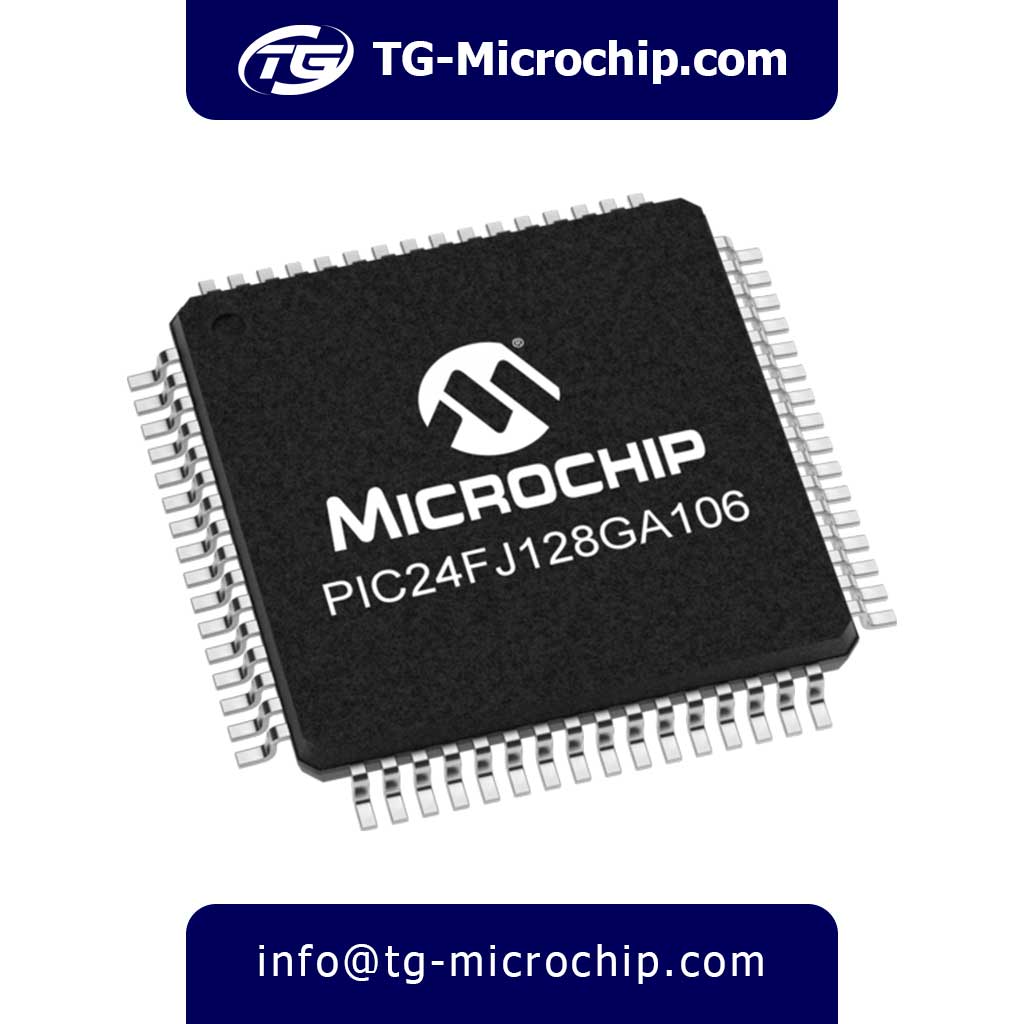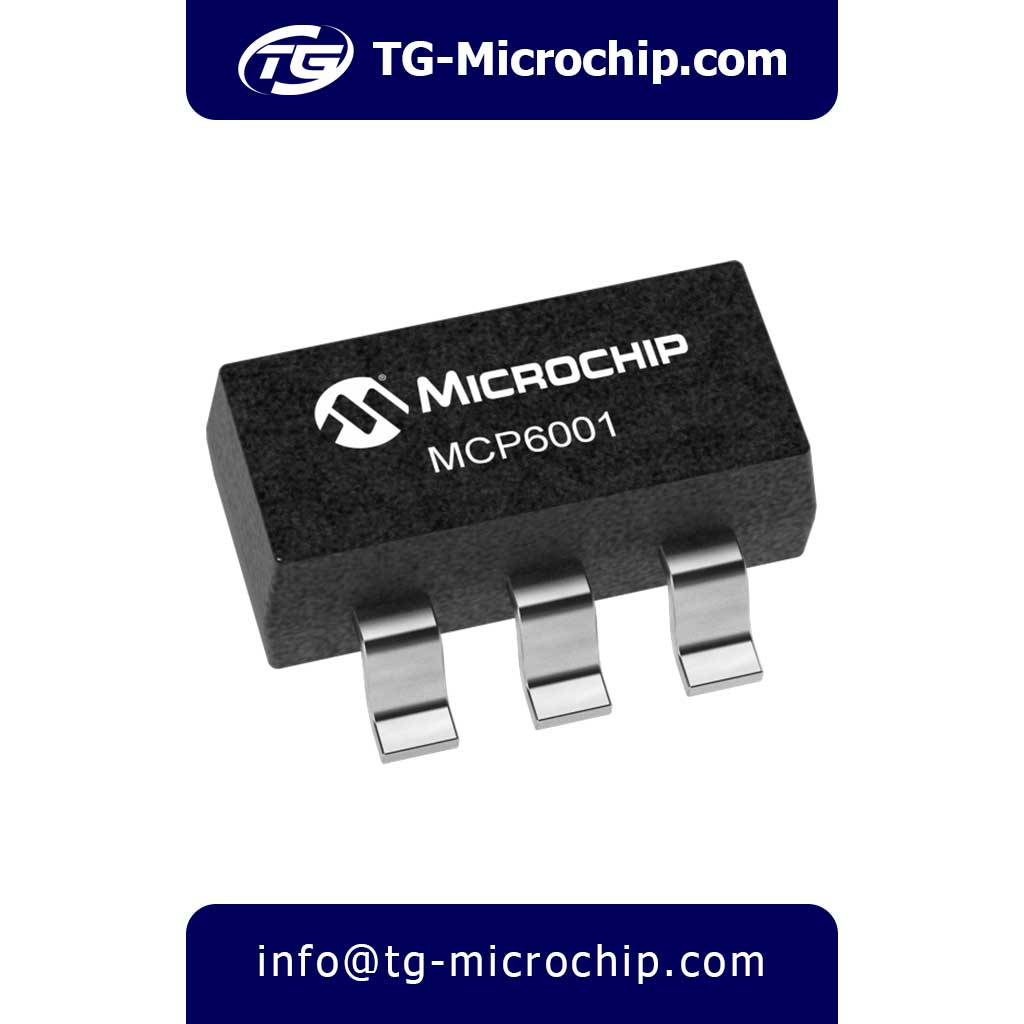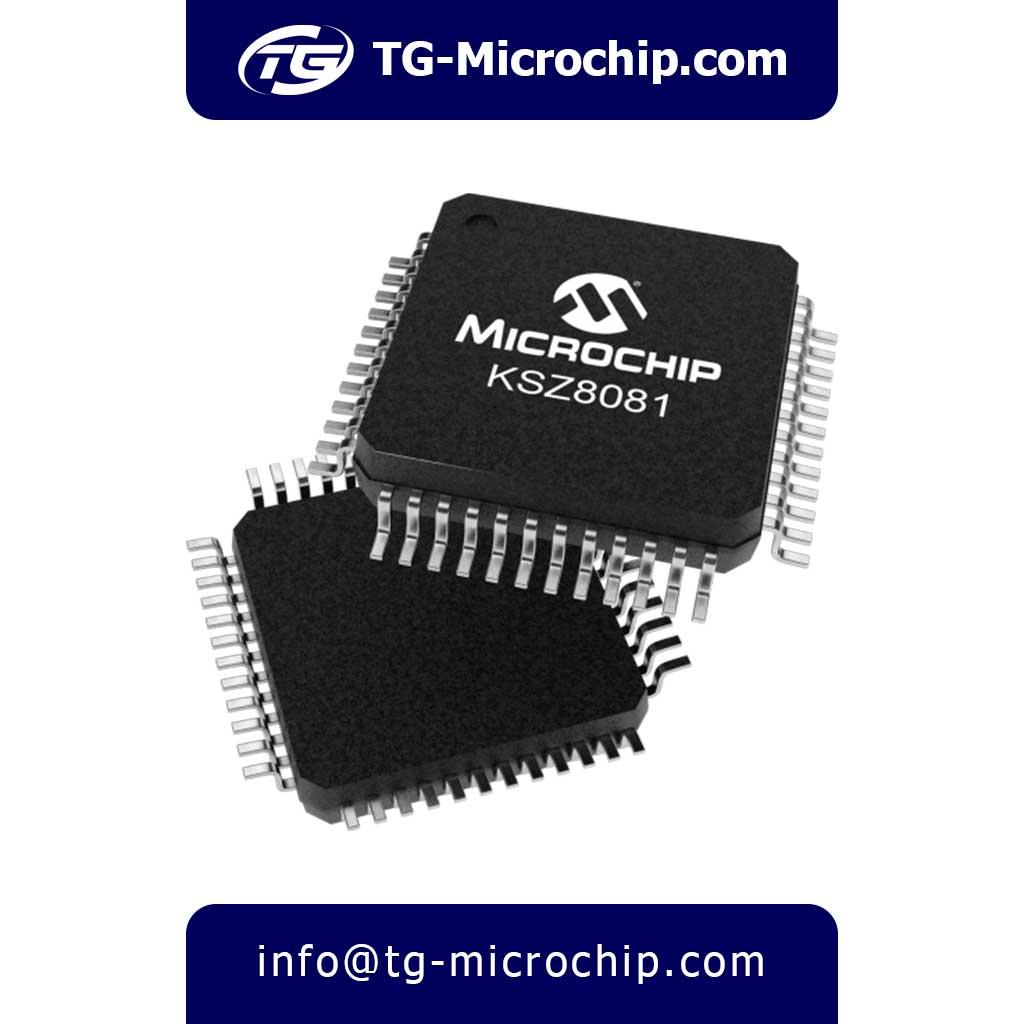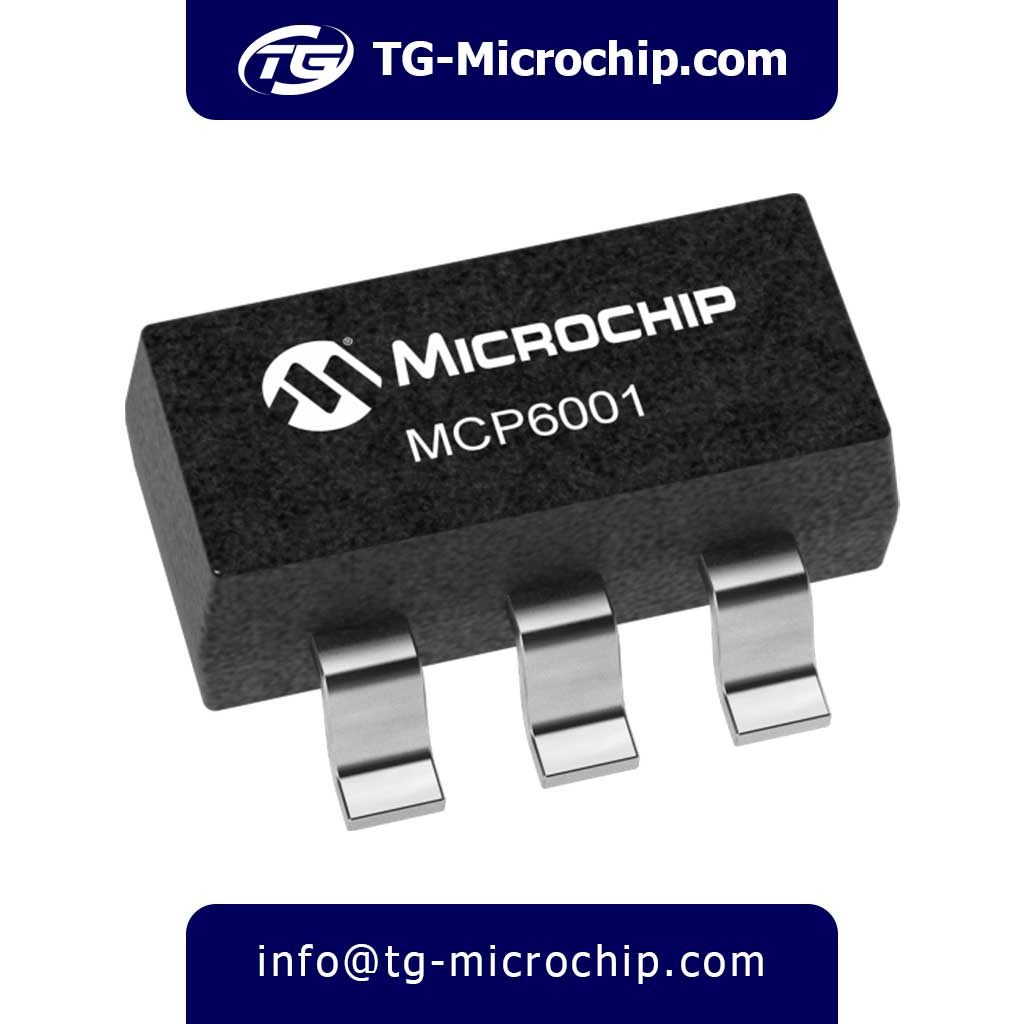For order or price inquiry of PIC24FJ32GA002-I/SS Microchip Technology / Atmel Please click on Buy Order button and fill the RFQ form we will check out inventory and offer you our best price .
Quick Access
About
The PIC24FJ32GA002-I/SS is a 16-bit microcontroller from Microchip Technology, designed for embedded applications requiring low power consumption, high performance, and flexible peripheral integration. Built on a modified Harvard architecture, it features a 16-bit RISC CPU core capable of executing up to 16 MIPS at 32 MHz, making it suitable for real-time control and sensor processing tasks. The device includes 32 KB of Flash memory for program storage and 8 KB of RAM for data handling, ensuring efficient operation in industrial, automotive, and consumer applications.
A key strength of this microcontroller is its eXtreme Low Power (XLP) technology, which minimizes energy consumption in battery-operated systems. It supports multiple power-saving modes, including Sleep (as low as 20 nA) and Doze mode, allowing dynamic clock scaling to balance performance and efficiency. The operating voltage range (2.0V to 3.6V) further enhances its suitability for portable and low-power designs. Additionally, features like Fail-Safe Clock Monitoring ensure reliable operation even during clock failures.
The PIC24FJ32GA002-I/SS offers a rich set of peripherals, including a 10-bit ADC (10 channels, 500 ksps), two analog comparators, and multiple communication interfaces (I²C, SPI, UART, and PMP). Its Peripheral Pin Select (PPS) functionality allows flexible I/O remapping, simplifying PCB layout. The microcontroller also includes five 16-bit timers, two 32-bit timers, and a Real-Time Clock/Calendar (RTCC) for time-sensitive applications.
Targeted at industrial and embedded systems, this microcontroller is part of Microchip’s PIC24FJ GA series, known for its robust feature set and scalability. It supports In-Circuit Serial Programming (ICSP) and JTAG boundary scan for easy debugging and firmware updates. The industrial temperature range (-40°C to +85°C) and RoHS compliance make it suitable for harsh environments and global markets.
In summary, the PIC24FJ32GA002-I/SS is a versatile, low-power 16-bit MCU ideal for applications such as IoT nodes, motor control, medical devices, and smart sensors. Its combination of high performance, energy efficiency, and extensive peripheral integration positions it as a strong alternative to 8-bit MCUs in designs requiring more computational power without transitioning to complex 32-bit architectures.
Features
Core & Performance
- 16-bit PIC24F RISC CPU core (Modified Harvard architecture)
- Up to 32 MHz operation (16 MIPS performance)
- 8-stage instruction pipeline for efficient execution
- 17-bit x 17-bit single-cycle hardware multiplier
- 32-bit x 16-bit hardware divider
- Dual partition Flash with live update capability
Memory
- 32 KB Flash program memory (11K x 24)
- 8 KB SRAM data memory (8K x 8)
- 1 KB Boot Flash for secure firmware updates
- Memory Protection Unit (MPU) for secure execution
Power Management
- 2.0V to 3.6V operating voltage range
- XLP (eXtreme Low Power) technology
- Sleep mode current: 20 nA (typ)
- Run mode current: 1.5 mA (at 32 MHz, 3.0V)
- Doze mode (CPU halted, peripherals active)
- Idle mode (CPU halted, selected peripherals active)
- Multiple power-saving modes (Sleep, Idle, Doze)
- Fast wake-up from Sleep (< 2 µs)
Clock System
- Internal Fast RC (FRC) oscillator (8 MHz, tunable)
- Internal Low-Power RC (LPRC) oscillator (32 kHz)
- External crystal/clock support (up to 32 MHz)
- Fail-Safe Clock Monitor (FSCM) for clock fault detection
- Phase-Locked Loop (PLL) for clock multiplication
Analog Peripherals
- 10-bit ADC
- 10 channels
- 500 kSPS conversion rate
- Auto-scan and threshold compare
- Two analog comparators
- Programmable reference voltage
- Wake-up from Sleep on change
Digital Peripherals
- Peripheral Pin Select (PPS) for flexible I/O mapping
- Five 16-bit timers (Timer1-5)
- Timer1 with gate control
- Timer2/3 and Timer4/5 can pair as 32-bit timers
- Two Capture/Compare/PWM (CCP) modules
- Hardware Real-Time Clock/Calendar (RTCC)
- Alarms, leap year correction, 32.768 kHz support
- Hardware CRC generator (16-bit, programmable polynomial)
Communication Interfaces
- UART (2 modules)
- LIN/IRDA support
- Hardware flow control (CTS/RTS)
- SPI (2 modules) (up to 8 Mbps)
- Frame error detection
- 16-bit FIFO buffer
- I²C (2 modules) (up to 1 Mbps)
- SMBus/PMBus compatible
- Multi-master support
- Parallel Master Port (PMP)
- 8/16-bit data bus
- Addressable external memory/peripheral interface
System Features
- Brown-Out Reset (BOR)
- Power-On Reset (POR)
- Power-Up Timer (PWRT)
- Oscillator Start-Up Timer (OST)
- Watchdog Timer (WDT) with dedicated LPRC oscillator
- In-Circuit Serial Programming (ICSP™)
- JTAG boundary scan support
I/O Capabilities
- 21 programmable I/O pins
- 5V-tolerant inputs (selectable per pin)
- Individually configurable pull-up/down resistors
- Open-drain control
- Interrupt-on-Change (IOC) for all pins
Packaging & Environmental
- 28-pin SSOP package (5.3mm body width)
- Industrial temperature range (-40°C to +85°C)
- AEC-Q100 qualified (automotive-grade variants available)
- RoHS3 compliant
Applications
Industrial Automation and Control Systems
- Motor Control Applications
- Precise control of brushed and brushless DC motors using integrated PWM modules and 16-bit timers
- Speed and torque regulation through advanced algorithms leveraging the hardware multiplier
- Position sensing and feedback systems utilizing the ADC and comparator peripherals
- Multi-axis coordination in industrial robotics through precise timing control
- Programmable Logic Controllers (PLCs)
- Digital I/O expansion and processing for industrial control systems
- Analog signal conditioning with the 10-bit ADC for process monitoring
- Communication gateway functionality through UART, SPI, and I²C interfaces
- Safety monitoring using the watchdog timer and brown-out reset features
- Industrial Sensor Interfaces
- Signal processing for various industrial sensors (pressure, flow, level)
- Temperature monitoring systems with analog and digital sensors
- Vibration analysis through high-speed sampling capabilities
- Industrial networking protocols implementation
Consumer Electronics
- Smart Home Devices
- Central control unit for home automation systems
- Energy management in smart thermostats and lighting controls
- Appliance control with timing and scheduling functions
- User interface implementations for touch panels and displays
- Personal Electronics
- Portable health and fitness monitoring devices
- Wearable technology with ultra-low power operation
- Personal medical devices with reliable operation
- Audio processing and control applications
- Household Appliances
- Advanced control systems for white goods
- User interface and display control
- Motor control in various appliances
- Energy monitoring and management
Automotive Electronics
- Body Electronics
- Lighting control systems with PWM dimming
- Power window and mirror control
- Seat positioning and memory systems
- Climate control interfaces
- Sensor Interfaces
- Tire pressure monitoring systems
- Fluid level sensing and monitoring
- Environmental condition monitoring
- Safety system sensors
- Auxiliary Control Units
- Entertainment system interfaces
- Display controllers
- Communication gateways
- Diagnostic interfaces
Medical Devices
- Patient Monitoring
- Vital signs monitoring equipment
- Portable diagnostic devices
- Wireless health monitors
- Medical sensor interfaces
- Therapeutic Devices
- Drug delivery systems
- Physical therapy equipment
- Rehabilitation devices
- Medical alert systems
- Laboratory Equipment
- Portable analyzers
- Diagnostic equipment
- Sample processing systems
- Data collection devices
Internet of Things (IoT) Applications
- Edge Nodes
- Sensor data aggregation
- Local processing and filtering
- Wireless communication interfaces
- Power management for battery operation
- Gateways
- Protocol translation
- Data concentration
- Network interfaces
- Security implementation
- Smart Sensors
- Environmental monitoring
- Industrial condition monitoring
- Agricultural sensing systems
- Building automation sensors
Security Systems
- Access Control
- Biometric systems
- Card reader interfaces
- Keypad processing
- Security protocol implementation
- Surveillance Systems
- Camera control interfaces
- Motion detection
- Alarm systems
- Communication interfaces
- Fire and Safety
- Smoke detection systems
- Gas monitoring
- Emergency lighting control
- Alarm notification systems
Power Management Systems
- Battery-Powered Devices
- Energy harvesting systems
- Power monitoring
- Charge control
- Battery management
- Renewable Energy
- Solar power systems
- Wind energy interfaces
- Power conversion control
- Energy storage management
- Power Distribution
- Smart grid interfaces
- Power monitoring
- Load control
- Protection systems
Human-Machine Interfaces
- Touch Interfaces
- Capacitive touch control
- Resistive touch processing
- Gesture recognition
- User feedback systems
- Display Control
- LCD interfaces
- LED matrix control
- Display drivers
- Graphics processing
- Control Panels
- Industrial HMI
- Appliance interfaces
- Automotive dashboards
- Medical device interfaces
Communication Systems
- Wired Communication
- RS-485 interfaces
- CAN bus systems
- Industrial protocols
- Network bridges
- Wireless Interfaces
- Bluetooth interfaces
- Zigbee systems
- LoRa applications
- Proprietary RF systems
- Gateways
- Protocol conversion
- Data concentration
- Network security
- Remote monitoring
Test and Measurement Equipment
- Portable Instruments
- Data loggers
- Handheld meters
- Environmental monitors
- Diagnostic tools
- Benchtop Equipment
- Signal generators
- Power supplies
- Measurement systems
- Calibration equipment
- Automated Test Systems
- Production testers
- Quality control systems
- End-of-line testers
- Burn-in systems
Aerospace and Defense
- Avionics
- Sensor interfaces
- Control systems
- Communication interfaces
- Monitoring systems
- Defense Systems
- Portable equipment
- Sensor networks
- Communication devices
- Control interfaces
- Satellite Systems
- Payload interfaces
- Communication systems
- Power management
- Data processing
Advantages
Power Efficiency & Low-Energy Operation
- Industry-leading ultra-low-power performance with XLP technology enables years of battery life in portable applications.
- Flexible power modes (Sleep, Idle, Doze) allow dynamic power scaling, optimizing energy use without sacrificing responsiveness.
- Fast wake-up (< 2 µs) from Sleep mode ensures quick reaction to external events while maintaining minimal power draw.
- Wide operating voltage range (2.0V–3.6V) supports direct battery operation without additional regulation.
Performance & Computational Capabilities
- 16 MIPS at 32 MHz provides deterministic real-time control, outperforming many 8-bit and low-end 16-bit competitors.
- Hardware multiplier/divider accelerates math operations, improving digital signal processing (DSP) and control algorithm execution.
- 8-stage instruction pipeline maximizes throughput, enabling efficient handling of complex embedded tasks.
Design Flexibility & System Integration
- Peripheral Pin Select (PPS) eliminates PCB layout constraints by allowing dynamic I/O remapping.
- Live Flash update capability enables field firmware upgrades without downtime.
- Comprehensive communication set (UART, SPI, I²C, PMP) simplifies interfacing with sensors, displays, and wireless modules.
- Real-Time Clock/Calendar (RTCC) with battery backup support removes need for external RTC chips in time-critical systems.
Reliability & Robust Operation
- Fail-Safe Clock Monitor (FSCM) prevents system lockups during clock failures, critical for safety-sensitive applications.
- Memory Protection Unit (MPU) guards against software errors, enhancing firmware stability.
- Industrial temperature range (-40°C to +85°C) ensures reliable operation in harsh environments.
- Brown-Out Reset (BOR) and Power-On Reset (POR) circuits guarantee stable startup under fluctuating power conditions.
Development & Time-to-Market Benefits
- Full MPLAB® X IDE support with advanced debugging tools reduces development cycles.
- Backward-compatible with PIC24F ecosystem allows reuse of existing code and hardware designs.
- In-Circuit Serial Programming (ICSP™) enables rapid prototyping without requiring external programmers.
- JTAG boundary scan support simplifies PCB testing during manufacturing.
Cost & Supply Chain Advantages
- Single-chip solution eliminates need for external components (e.g., RTC, watchdog, voltage monitors).
- Long-term availability commitment from Microchip ensures design longevity for industrial products.
- RoHS3 compliance future-proofs designs against evolving environmental regulations.
Application-Specific Benefits
- Medical devices benefit from low leakage current and robust ESD protection.
- Automotive systems leverage AEC-Q100 qualification for non-critical ECUs.
- IoT edge nodes utilize the optimal balance of performance and power efficiency.
- Industrial controls exploit deterministic operation and wide temperature range.
Specifications
| Category | Specification |
|---|---|
| Manufacturer | Microchip Technology |
| Manufacturer Part No. | PIC24FJ32GA002-I/SS |
| Product Category | 16-bit Microcontrollers (MCU) |
| Product Type | 16-bit Microcontroller |
| Series | PIC24FJ GA (Low-Power, General Purpose) |
| Core Processor | PIC24 (16-bit RISC) (Modified Harvard Architecture) |
| Core Size | 16-Bit |
| Package / Case | SSOP-28 (208mil, 5.3mm width) |
| Mounting Type | Surface Mount (SMD) |
| Operating Frequency | Up to 32 MHz (16 MIPS performance) |
| Program Memory Size | 32 KB Flash (11K x 24) |
| RAM Size | 8 KB (8K x 8) |
| EEPROM Size | None (No integrated EEPROM) |
| Number of I/O Pins | 21 (Multifunction GPIO with PPS) |
| Peripherals | BOR, LVD, POR, PWM, WDT, 2x Comparators, PPS, CRC, RTCC |
| Connectivity | I²C, SPI, UART/USART, PMP (Parallel Master Port) |
| ADC Channels | 10-channel, 10-bit (500 ksps max sampling rate) |
| DAC Channels | None |
| Timers | 5x 16-bit, 2x 32-bit (Timer1 with Gate Control) |
| Operating Voltage | 2.0V to 3.6V (Low-Power Operation) |
| Operating Temperature | -40°C to +85°C (Industrial Grade) |
| Low Power Features | XLP (eXtreme Low Power) (Sleep current: 20 nA) |
| Oscillator Type | Internal Fast RC (FRC), External Crystal Support |
| Motor Control PWM | None (No dedicated PWM for motor control) |
| USB Interface | None |
| CAN Interface | None |
| Special Features | Peripheral Pin Select (PPS), Hardware CRC, RTCC (Real-Time Clock/Calendar) |
| Qualification | AEC-Q100 (Automotive-grade) (Not all variants, check datasheet) |
| RoHS Compliance | Yes (RoHS3 Compliant) |
| MSL Rating | MSL 1 – Unlimited (Moisture Sensitivity Level) |
| ECCN | 3A991A2 (Export Control Classification) |
Comparison with Similar Components
1. Core Architectural Comparison
| Part Number | Core Architecture | Max Clock Speed | Instruction Pipeline | Hardware Accelerators | Memory Protection |
|---|---|---|---|---|---|
| PIC24FJ32GA002-I/SS | 16-bit PIC24 RISC | 32 MHz | 8-stage | 17×17 Multiplier, 32/16 Divider | Basic MPU |
| PIC24FJ64GA004-I/SS | 16-bit PIC24 RISC | 32 MHz | 8-stage | 17×17 Multiplier, 32/16 Divider | Basic MPU |
| PIC24F32KA302T-I/SS | 16-bit PIC24 XLP | 32 MHz | 8-stage | 17×17 Multiplier, 32/16 Divider | Enhanced MPU |
| PIC24F16KM202-I/SS | 16-bit PIC24 XLP+ | 32 MHz | 8-stage | DSP Engine, 32×16 MAC | Full MPU |
| PIC24FJ128GA010-I/SS | 16-bit PIC24 RISC | 32 MHz | 8-stage | 17×17 Multiplier, 32/16 Divider | Basic MPU |
Key Observations:
- The PIC24FJ32GA002 shares the same core architecture with most PIC24F devices but lacks DSP extensions found in KM series
- All compared devices feature the same 8-stage pipeline for efficient instruction execution
- Memory protection varies significantly, with KM series offering the most robust implementation
2. Memory Configuration Analysis
| Part Number | Flash (KB) | RAM (KB) | Bootloader Support | Flash Partitioning | EEPROM Emulation |
|---|---|---|---|---|---|
| PIC24FJ32GA002-I/SS | 32 | 8 | Yes | Dual-bank | Software |
| PIC24FJ64GA004-I/SS | 64 | 8 | Yes | Dual-bank | Software |
| PIC24F32KA302T-I/SS | 32 | 4 | Yes | Single-bank | Hardware |
| PIC24F16KM202-I/SS | 16 | 4 | No | Single-bank | Hardware |
| PIC24FJ128GA010-I/SS | 128 | 16 | Yes | Quad-bank | Software |
Memory Considerations:
- The PIC24FJ32GA002 offers optimal memory for mid-range applications with dual-bank flash for live updates
- KA and KM series provide hardware EEPROM emulation, beneficial for data logging applications
- Larger memory variants (128GA010) support more complex firmware with quad-bank flash architecture
3. Analog Performance Breakdown
| Part Number | ADC Resolution | ADC Channels | Max Sample Rate | Input Range | PGA Available | Comparator Channels |
|---|---|---|---|---|---|---|
| PIC24FJ32GA002-I/SS | 10-bit | 10 | 500 ksps | 0-VREF | No | 2 |
| PIC24FJ64GA004-I/SS | 10-bit | 10 | 500 ksps | 0-VREF | No | 2 |
| PIC24F32KA302T-I/SS | 12-bit | 13 | 1 Msps | 0-VREF | Yes | 4 |
| PIC24F16KM202-I/SS | 12-bit | 19 | 1.2 Msps | 0-VREF | Yes | 4 |
| PIC24FJ128GA010-I/SS | 10-bit | 16 | 500 ksps | 0-VREF | No | 4 |
Analog Performance Notes:
- KA and KM series clearly lead in analog performance with higher resolution and sample rates
- The PIC24FJ32GA002’s 10-bit ADC is adequate for basic sensing but lacks PGA available in higher-end models
- Input ranges are comparable across all devices, but KM series offers better noise immunity
4. Digital Peripheral Comparison
| Part Number | PWM Channels | Timer Modules | Capture/Compare | QEI Interfaces | Hardware CRC | PPS Flexibility |
|---|---|---|---|---|---|---|
| PIC24FJ32GA002-I/SS | 5 | 5×16-bit | 2 | 1 | Yes | Full |
| PIC24FJ64GA004-I/SS | 5 | 5×16-bit | 2 | 1 | Yes | Full |
| PIC24F32KA302T-I/SS | 3 | 5×16-bit | 1 | 0 | Yes | Limited |
| PIC24F16KM202-I/SS | 5 | 5×16-bit | 2 | 1 | Yes | Full |
| PIC24FJ128GA010-I/SS | 9 | 5×16-bit | 4 | 2 | Yes | Full |
Digital Peripheral Insights:
- The PIC24FJ32GA002 provides balanced digital peripheral support for most control applications
- Higher pin-count devices (128GA010) offer significantly more PWM and capture channels
- KA series shows some peripheral limitations due to its focus on low-power operation
5. Communication Interface Matrix
| Part Number | UART | SPI | I²C | CAN | USB | LIN | PMP | IrDA | SENT | PS/2 |
|---|---|---|---|---|---|---|---|---|---|---|
| PIC24FJ32GA002-I/SS | 2 | 2 | 2 | – | – | Yes | Yes | Yes | – | – |
| PIC24FJ64GA004-I/SS | 2 | 2 | 2 | – | – | Yes | Yes | Yes | – | – |
| PIC24F32KA302T-I/SS | 2 | 1 | 1 | – | – | Yes | – | – | – | – |
| PIC24F16KM202-I/SS | 2 | 2 | 2 | – | – | Yes | – | Yes | Yes | – |
| PIC24FJ128GA010-I/SS | 2 | 2 | 2 | 1 | – | Yes | Yes | Yes | – | Yes |
Communication Capability Analysis:
- All devices maintain basic UART/SPI/I²C support
- The PIC24FJ32GA002 stands out with PMP (Parallel Master Port) for memory interfacing
- Higher-end models add specialized protocols like CAN and SENT for automotive applications
6. Power Management Features
| Part Number | Operating Voltage | Sleep Current | Active Current/MHz | Power Modes | BOR Options | Voltage Monitor |
|---|---|---|---|---|---|---|
| PIC24FJ32GA002-I/SS | 2.0-3.6V | 20 nA | 150 µA | 5 | 4-level | Basic |
| PIC24FJ64GA004-I/SS | 2.0-3.6V | 20 nA | 150 µA | 5 | 4-level | Basic |
| PIC24F32KA302T-I/SS | 1.8-3.6V | 15 nA | 90 µA | 7 | 8-level | Advanced |
| PIC24F16KM202-I/SS | 1.8-5.5V | 10 nA | 75 µA | 7 | 8-level | Advanced |
| PIC24FJ128GA010-I/SS | 2.0-3.6V | 25 nA | 180 µA | 5 | 4-level | Basic |
Power Efficiency Findings:
- KA and KM series demonstrate superior power efficiency with wider voltage ranges
- The PIC24FJ32GA002 provides respectable low-power performance but can’t match XLP-focused devices
- Advanced brown-out protection in KA/KM series enhances reliability in unstable power conditions
7. Development Ecosystem Support
| Part Number | MPLAB X Support | Harmony Compatible | Code Examples | Debug Tools | Third-Party IDE | RTOS Support |
|---|---|---|---|---|---|---|
| PIC24FJ32GA002-I/SS | Full | Yes | Extensive | All | Many | Excellent |
| PIC24FJ64GA004-I/SS | Full | Yes | Extensive | All | Many | Excellent |
| PIC24F32KA302T-I/SS | Full | Limited | Moderate | All | Some | Good |
| PIC24F16KM202-I/SS | Full | Limited | Moderate | All | Some | Good |
| PIC24FJ128GA010-I/SS | Full | Yes | Extensive | All | Many | Excellent |
Development Considerations:
- The PIC24FJ32GA002 benefits from excellent ecosystem support as part of the mainstream PIC24F family
- XLP-focused devices (KA/KM) have slightly more limited software framework compatibility
- All devices support full debugging capabilities through Microchip’s toolchain
Comprehensive Recommendations
For General-Purpose Applications:
The PIC24FJ32GA002-I/SS represents the best balance of performance, power efficiency, and peripheral integration for typical embedded control applications. Its combination of 32KB Flash, 8KB RAM, and full peripheral set makes it ideal for:
- Industrial control systems
- Consumer electronics
- Basic motor control applications
- IoT edge nodes
When to Choose Alternatives:
- Ultra-Low Power Designs: PIC24F32KA302T-I/SS (better sleep currents) or PIC24F16KM202-I/SS (wider voltage range)
- High-Performance Needs: PIC24FJ128GA010-I/SS (more memory and peripherals)
- Precision Analog Systems: PIC24F32KA302T-I/SS (12-bit ADC with PGA)
- Automotive Applications: PIC24FJ128GA010-I/SS (CAN support)
Final Technical Assessment:
The PIC24FJ32GA002-I/SS maintains its position as the most versatile option in the 28-pin PIC24F family. While specialized variants exist for particular requirements, this device offers the best combination of:
- Adequate memory for complex firmware
- Comprehensive peripheral set
- Good power efficiency
- Excellent development support
- Cost-effective packaging options
Frequently Asked Questions (FAQs)
General Questions
- What is the PIC24FJ32GA002-I/SS?
A 16-bit microcontroller from Microchip Technology with 32KB Flash, 8KB RAM, and low-power operation. - What package does it come in?
SSOP-28 (208mil, 5.3mm width). - What is the operating voltage range?
2.0V to 3.6V. - What is the maximum clock speed?
32 MHz (16 MIPS). - Is it RoHS compliant?
Yes, RoHS3 compliant. - What temperature range does it support?
-40°C to +85°C (industrial grade). - Does it have an FPU (Floating-Point Unit)?
No, but it includes a hardware multiplier/divider. - Is it automotive-qualified?
No, but industrial variants (PIC24FJ32GA002-E/SS) support -40°C to +125°C. - What is the difference between PIC24FJ32GA002-I/SS and PIC24FJ32GA002-E/SS?
The “-E” variant has an extended temperature range (-40°C to +125°C). - Does it support JTAG debugging?
Yes, it supports JTAG boundary scan and ICSP.
Memory & Storage
- How much Flash memory does it have?
32 KB. - What is the RAM size?
8 KB. - Does it have EEPROM?
No, but EEPROM can be emulated in Flash. - Can the Flash be reprogrammed in-circuit?
Yes, via ICSP or self-programming. - Does it support bootloading?
Yes, with 1 KB Boot Flash. - Is the memory protected?
Yes, it has a basic Memory Protection Unit (MPU). - Can it execute from RAM?
No, it uses a Harvard architecture (executes from Flash). - Does it support external memory?
Yes, via the Parallel Master Port (PMP). - How many write/erase cycles does Flash support?
10,000 cycles (typical). - Is Flash partitioning supported?
Yes, dual-bank partitioning for live updates.
Power & Low-Power Modes
- What is the typical active current at 32 MHz?
~1.5 mA at 3.0V. - What is the sleep mode current?
20 nA (typical with XLP). - What power-saving modes are available?
Sleep, Idle, and Doze modes. - How fast is wake-up from Sleep?
< 2 µs. - Does it have a built-in voltage regulator?
No, it requires an external supply. - What is the brown-out reset (BOR) voltage?
Configurable (4-level thresholds). - Can it operate at 5V?
No, max voltage is 3.6V. - Does it support dynamic voltage scaling?
No, but clock scaling (Doze mode) is available. - What is the power-on reset (POR) threshold?
~1.85V (typical). - Does it monitor supply voltage?
Yes, via a low-voltage detect (LVD) module.
Peripherals & I/O
- How many I/O pins are available?
21 (multifunction GPIO). - Does it support 5V-tolerant inputs?
Yes, but only on select pins. - What ADC resolution does it have?
10-bit, 10 channels, 500 ksps. - Does it have a DAC?
No. - How many PWM channels are available?
5. - Does it have analog comparators?
Yes, 2 comparators with programmable reference. - What communication interfaces are supported?
UART, SPI, I²C, and PMP. - Does it support USB or CAN?
No, higher-end models (e.g., PIC24FJ128GA010) do. - Can I remap peripheral pins?
Yes, via Peripheral Pin Select (PPS). - Does it have a Real-Time Clock (RTC)?
Yes, RTCC with alarm support.
Development & Tools
- Which IDE supports this MCU?
MPLAB X IDE (official Microchip tool). - What debuggers are compatible?
PICkit™ 4, ICD 4, and MPLAB Snap. - Is it supported by MPLAB Harmony?
Yes, but with limited middleware for this series. - Are there code examples available?
Yes, in Microchip’s GitHub and MPLAB Code Configurator (MCC). - Does it work with third-party IDEs?
Yes (e.g., IAR Embedded Workbench, MikroC). - Is there an RTOS available?
FreeRTOS and MPLAB Harmony RTOS are compatible. - Can I program it in C++?
Yes, but most libraries are written for C. - Does it support Arduino?
No official support, but third-party cores exist. - What compilers are recommended?
XC16 (Microchip’s official compiler). - Where can I find the datasheet?
Microchip’s website and end if this page.
Datasheet
PIC24FJ32GA002-I/SS Microchip Technology / Atmel Datasheet
Contact us for more information
Contact us for more information and stock inventory inquiry of PIC24FJ32GA002-I/SS Microchip Technology / Atmel.
China Email : info@tg-microchip.com
Hong Kong Email : hk@tg-microchip.com
Russia Email : russia@tg-microchip.com

